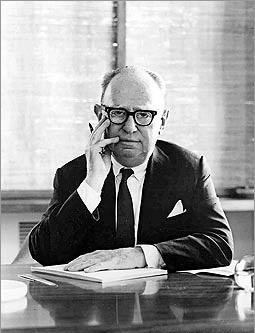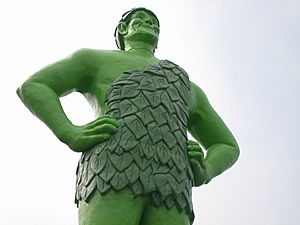Leo Burnett facts for kids
Quick facts for kids
Leo Burnett
|
|
|---|---|
 |
|
| Born | October 21, 1891 St. Johns, Michigan U.S.
|
| Died | June 7, 1971 (aged 79) |
| Nationality | American |
| Alma mater | University of Michigan (B.S., 1914) |
| Occupation | Advertising Executive |
| Known for | Founder of Leo Burnett Worldwide |
| Spouse(s) |
Naomi Geddles
(m. 1918) |
| Children | Peter Burnett Joseph Burnett Phoebe Snetsinger |
Leo Burnett (born October 21, 1891 – died June 7, 1971) was a famous American advertising expert. He started his own company, Leo Burnett Company, Inc.. He created many well-known characters and ad campaigns in the 20th century. Some of these include Tony the Tiger, the Marlboro Man, and the Maytag Repairman. He also worked with big companies like McDonald's, Hallmark, and Coca-Cola. In 1999, Time magazine named him one of the 100 most important people of the 20th century.
Contents
About Leo Burnett's Life
Leo Burnett was born in St. Johns, Michigan, on October 21, 1891. His parents were Noble and Rose Clark Burnett. His father, Noble, owned a dry goods store. Young Leo helped his father and watched him design ads for the business. After high school, Burnett studied journalism at the University of Michigan. He earned his bachelor's degree in 1914.
Early Career in Journalism and Advertising
Burnett's first job was as a reporter for the Peoria Journal Star newspaper. This was in Peoria, Illinois. In 1917, he moved to Detroit. There, he got a job editing a magazine for Cadillac Motor Car Company. This magazine was called Cadillac Clearing House. Later, he became the advertising director for Cadillac. At Cadillac, Burnett met Theodore F. MacManus, who became his advertising mentor. Burnett called MacManus "one of the great advertising men of all time."
In 1918, Burnett married Naomi Geddes. They met at a restaurant near the Cadillac offices. Naomi worked there as a cashier. They had three children: Peter, Joseph, and Phoebe.
During World War I, Burnett joined the Navy for six months. He mostly worked at Naval Station Great Lakes. After his Navy service, Burnett returned to Cadillac. Later, he moved to Indianapolis to work for LaFayette Motors Company. He then joined Homer McKee's advertising agency. This was his first job at an advertising agency. Burnett learned a lot from McKee about making ads that connect with people.
After working at McKee's for ten years, Burnett moved to Chicago in 1930. He worked for Erwin, Wasey & Company for five years.
Founding His Own Company
In 1935, Leo Burnett started his own company, the Leo Burnett Company, Inc. His office was on the 18th floor of the London Guarantee Building. Today, his company is very large. It has over 9,000 employees in more than 85 offices around the world.
In December 1967, near the end of his career, Burnett gave a famous speech. It was called "When To Take My Name Off The Door." He gave it at his agency's holiday party.
Leo Burnett passed away on June 7, 1971. He was 79 years old. He died from a heart attack at his family farm in Hawthorn Woods, Illinois. He is buried at Rosehill Cemetery in Chicago.
The Leo Burnett Company's Growth
The Leo Burnett Company, Inc. started in 1935. It began as a private company. It had $50,000 to start, eight employees, and three clients. Now, it is part of Publicis Groupe. Leo Burnett is one of the biggest advertising networks globally. It has 85 offices in 69 countries and over 9,000 employees.
In its first few years, the company made about $1 million each year. By 1950, this grew to $22 million. By 1954, it was $55 million a year. By the end of the 1950s, the Leo Burnett Company was making $100 million annually.
Companies Leo Burnett Worked With
Leo Burnett and his company created ads for many well-known brands:
- Allstate (1957)
- Commonwealth Edison (1954)
- First Brands (1961)
- General Motors Oldsmobile (1967)
- Green Giant (1935)
- Heinz Pet Products (1958)
- Keebler Co. (1968)
- Kellogg's (1949)
- Kraft Foods (1984)
- Mattel (1970)
- Maytag (1955)
- Memorex (1968)
- Nestlé (1967)
- Philip Morris Co. (1954)
- Pillsbury (1944)
- Procter & Gamble (1952)
- Schlitz Brewing Company (1961)
- Starkist (1958)
- United Airlines (1965)
Famous Ad Creations
Burnett's company created many memorable characters and campaigns:
- Hubert The Lion (for Harris Bank)
- Jolly Green Giant (for Green Giant)
- Keebler Elves (for Keebler)
- The Marlboro Man (for Phillip Morris Co.)
- Maytag Repairman (for Maytag)
- Morris the Cat (for 9 Lives)
- Pillsbury Doughboy (for Pillsbury)
- Tony The Tiger (for Kellogg's Frosted Flakes)
- Toucan Sam (for Kellogg's Froot Loops)
Leo Burnett's Advertising Style
Burnett believed in showing the "real drama" of products in his ads. He used a "soft sell" approach. This means he focused on building a brand's image and feelings, rather than just pushing a sale. He wanted ads to feel warm and connect with people's emotions and experiences. His ads often used simple, strong images that spoke to everyday people.
Using "Cultural Archetypes"
Burnett was also known for creating "cultural archetypes." These were like mythical characters that represented American values. Good examples are the Jolly Green Giant, the Pillsbury Doughboy, Tony the Tiger, and the Marlboro Man. These characters helped make the products famous and relatable.
"Corny Language" Folder
Burnett had a special folder on his desk called "Corny Language." He collected words, phrases, and ideas that he thought were perfect for expressing an idea in a simple, clear way.
Public Service Advertising
In 1947, Burnett wrote a booklet called The Good Citizen. This booklet talked about the duties and rights of being a U.S. citizen. He did this as a public service for The Advertising Council and The American Heritage Foundation.
Images for kids
See also
 In Spanish: Leo Burnett para niños
In Spanish: Leo Burnett para niños



